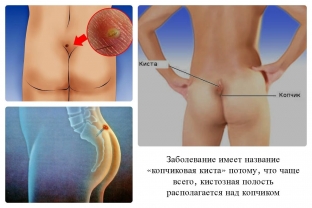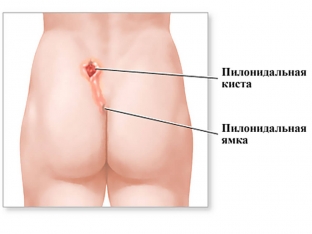Lower pain, limited movement, fever – such symptoms may be the cause of the development of a pilonidal cyst of the coccyx. "Pilonidal" is translated from Latin as "a nest of hair." The cyst is an opening between the buttocks of your anus, the surface of which may be covered with hair, and over time may fester and bother. The cyst requires surgical treatment so that the disease does not go through a series of remissions and relapses. Men are 4 times more likely to suffer from this disease. The cyst of the coccyx is a congenital anomaly, which at first does not manifest itself in any way, and after a certain push, it begins to fester and requires surgical intervention. Basically, removal of the cyst of the coccyx leads to a complete recovery,
What is a pilonidal cystCoccyx cyst has many names: coccyx fistula, dermoid cyst, pilonidal cyst, pilonidal sinus, epithelial coccygeal tract. This disease is an inflammation of the cavity (funnel, holes) with hairline under the skin in & nbsp; upper part of the intergluteal fold. The cyst is visible to the naked eye – the presence of a hole, which can be quite deep, in appearance resembles a funnel sent by hair. Hair, sweat, bacteria, and other debris enter the cyst through the hole. The accumulated dirt in the cyst is the cause of the abscess. Usually, the coccyx cyst becomes inflamed at the age of 14 to 40 years, during the active working season. Therefore, suppuration greatly reduces the quality of human life and the only way out to be cured may be the removal of the coccyx cyst. Here it should be taken into account that excision entails a long postoperative rehabilitation period, which can be up to 6 weeks in the hospital and some more time at home. What are the causes of the inflammatory process and the main symptoms that indicate an exacerbation?

Scientists claim that a person who has an increased degree of body hair has an increased chance of developing a pilonidal cyst and the aggravation process. This is due to the ingrowth of hair inside the intergluteal fold and the formation of a fistula or funnel. Even in the womb, the embryo has deviations in the development of the tail. Such an anomaly in the future may be the cause of the development of a coccyx cyst.
Factors for the development of the disease that provoke exacerbations:
- sedentary lifestyle;
- presence of follicles, blocked pores;
- presence of infectious diseases;
- reduced immunity;
- heredity;
- hypothermia;
- mechanical damage.
If the pilonidal cyst develops into a complicated form and pus begins to accumulate, then the symptoms are clearly expressed, cause severe discomfort to the patient and require immediate contact with a specialist for treatment and removal of the coccyx cyst.
Symptoms of inflammation of the coccyx cyst:
- in the region of the intergluteal fold, an opening, a funnel are palpable, causing discomfort;
- the skin turns red, inflamed, the size may increase and pass the gluteal line to one side;
- pus oozing from the hole between the buttocks;
- during inflammation, secondary cyst openings may appear, which can be active and bring the accumulated pus out;
- body temperature may rise significantly;
- pain while sitting or lying down.

If the pilonidal cyst begins to accumulate pus and disturb the person, then it is necessary to remove the coccyx cyst in two stages.
First stage: opening the abscess and removing the pus. After opening, it is necessary to withstand time until the inflammation subsides – 1-2 weeks.
Second stage: surgical excision of the cyst – produced in one block, within healthy tissues. During surgery, it is important to keep the cyst intact to prevent infection of healthy tissue. The surgeon may suture the wound or leave it open if the stretch on the skin edges is too great, leading to subsequent rupture and difficulty in healing. The edges of the wound can be very stretched, which leads to an increase in healing time and discomfort for a long time.
It is important to remember: after the operation, the patient must always be in a standing position or lying on his stomach for at least a week. It is even necessary to relieve the need while standing, so as not to damage the wound. The patient may stay in the hospital for about 2 weeks after the operation. Also, for successful healing, it is necessary to bandage the wound once a day so that the infection does not get in.
Sometimes the first operation may result in a new cyst if the surgeon has not completely removed the ramifications of the cyst, so another operation may be required. Although this happens very rarely.






Add a comment